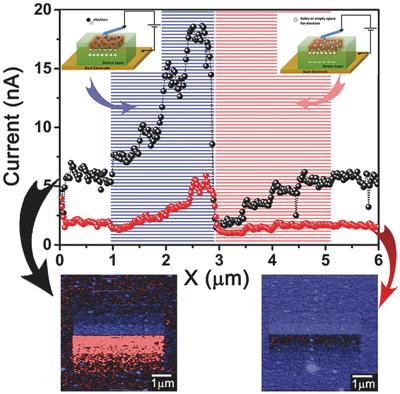当前位置:
X-MOL 学术
›
Adv. Mater.
›
论文详情
Our official English website, www.x-mol.net, welcomes your
feedback! (Note: you will need to create a separate account there.)
“Electro‐Typing” on a Carbon‐Nanoparticles‐Filled Polymeric Film using Conducting Atomic Force Microscopy
Advanced Materials ( IF 27.4 ) Pub Date : 2017-11-02 , DOI: 10.1002/adma.201703079 Sumita Goswami 1 , Suman Nandy 1 , Arghya Narayan Banerjee 2 , Asal Kiazadeh 1 , Gowra Raghupathy Dillip 2 , Joana V. Pinto 1 , Sang Woo Joo 2 , Rodrigo Martins 1 , Elvira Fortunato 1
Advanced Materials ( IF 27.4 ) Pub Date : 2017-11-02 , DOI: 10.1002/adma.201703079 Sumita Goswami 1 , Suman Nandy 1 , Arghya Narayan Banerjee 2 , Asal Kiazadeh 1 , Gowra Raghupathy Dillip 2 , Joana V. Pinto 1 , Sang Woo Joo 2 , Rodrigo Martins 1 , Elvira Fortunato 1
Affiliation

|
Next‐generation electrical nanoimprinting of a polymeric data sheet based on charge trapping phenomena is reported here. Carbon nanoparticles (CNPs) (waste carbon product) are deployed into a polymeric matrix (polyaniline) (PANI) as a charge trapping layer. The data are recorded on the CNPs‐filled polyaniline device layer by “electro‐typing” under a voltage pulse (VET, from ±1 to ±7 V), which is applied to the device layer through a localized charge‐injection method. The core idea of this device is to make an electrical image through the charge trapping mechanism, which can be “read” further by the subsequent electrical mapping. The density of stored charges at the carbon–polyaniline layer, near the metal/polymer interface, is found to depend on the voltage amplitude, i.e., the number of injected charge carriers. The relaxation of the stored charges is studied by different probe voltages and for different devices, depending on the percolation of the CNPs into the PANI. The polymeric data sheet retains the recorded data for more than 6 h, which can be refreshed or erased at will. Also, a write–read–erase–read cycle is performed for the smallest “bit” of stored information through a single contact between the probe and the device layer.
中文翻译:

使用导电原子显微镜在碳纳米粒子填充的聚合物薄膜上进行“电子分型”
本文报道了基于电荷俘获现象的聚合物数据表的下一代电纳米压印。碳纳米颗粒(CNP)(废碳产品)被部署到聚合物基质(聚苯胺)(PANI)中作为电荷捕获层。在电压脉冲(V ET)下通过“电键入”将数据记录在CNP填充的聚苯胺器件层上(从±1到±7 V),这是通过局部电荷注入方法施加到器件层的。该设备的核心思想是通过电荷捕获机制制作电子图像,可以通过随后的电子映射进一步“读取”该图像。发现在金属/聚合物界面附近的碳-聚苯胺层存储的电荷密度取决于电压幅度,即注入的电荷载流子的数量。取决于CNP渗入PANI的方式,通过不同的探针电压和针对不同的器件来研究所存储电荷的弛豫。聚合物数据表将记录的数据保留超过6小时,可以随意刷新或删除。还,
更新日期:2017-11-02
中文翻译:

使用导电原子显微镜在碳纳米粒子填充的聚合物薄膜上进行“电子分型”
本文报道了基于电荷俘获现象的聚合物数据表的下一代电纳米压印。碳纳米颗粒(CNP)(废碳产品)被部署到聚合物基质(聚苯胺)(PANI)中作为电荷捕获层。在电压脉冲(V ET)下通过“电键入”将数据记录在CNP填充的聚苯胺器件层上(从±1到±7 V),这是通过局部电荷注入方法施加到器件层的。该设备的核心思想是通过电荷捕获机制制作电子图像,可以通过随后的电子映射进一步“读取”该图像。发现在金属/聚合物界面附近的碳-聚苯胺层存储的电荷密度取决于电压幅度,即注入的电荷载流子的数量。取决于CNP渗入PANI的方式,通过不同的探针电压和针对不同的器件来研究所存储电荷的弛豫。聚合物数据表将记录的数据保留超过6小时,可以随意刷新或删除。还,









































 京公网安备 11010802027423号
京公网安备 11010802027423号